The Toshiba PX04S Series is a third generation enterprise SAS SSD. The PX04S Series are 2.5”, 15mm SSDs with the largest capacity currently available of any 12Gbps SSD, at 3.84TB. The Toshiba PX04S family is comprised of 4 different models that cater to specific needs. There is a High-Endurance, Mid-Endurance, Value-Endurance, and Read Intensive model. The new PX04S also comes in a self-encrypting drive model that has instant secure erase and supports pin-3 power disable. The PX04S is dual ported and comes with a performance option that enables users to increase write performance by as much as 47%.
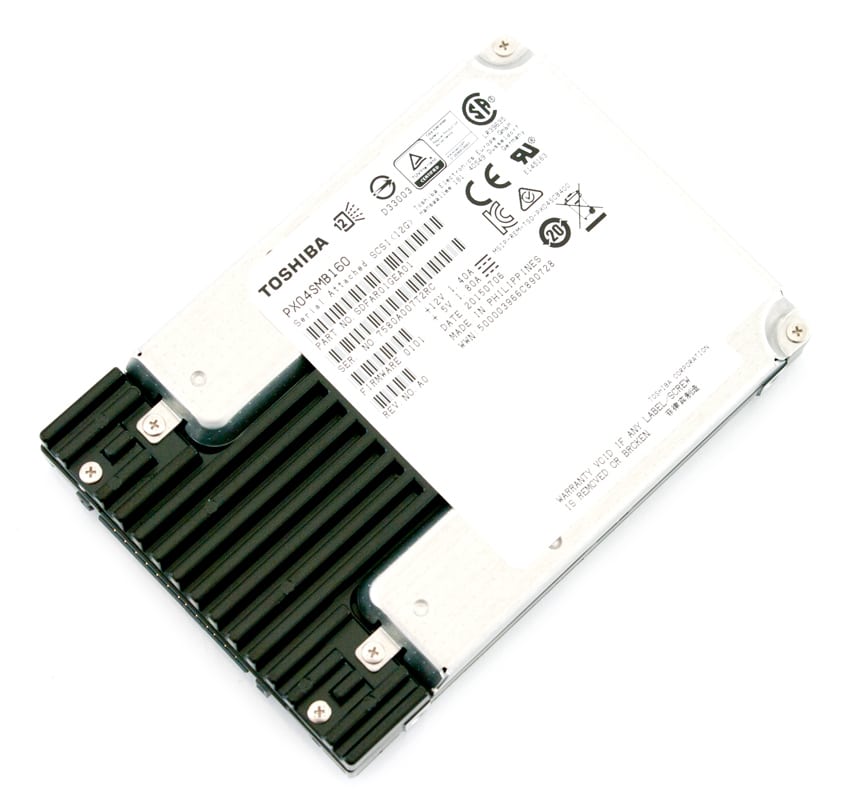
Toshiba offers four distinct models that can tackle different workloads or support various levels of tiering in an array. The High Endurance model is ideal for write-intensive virtualized datacenters, big data analytics, and HPC. The drive ranges in capacity from 200GB to 1.6TB and supports 25 complete drive writes per day. The Mid-Endurance comes in capacities as high as 3.2TB and is aimed at mixed-use, mission-critical hyperscale, virtualized environments, OLTP, and e-commerce. The Mid-Endurance supports 10 complete drive writes per day. The Value-Endurance model has a balance of capacity, performance, and endurance. This drive is ideal for read-intensive storage and server applications such as media streaming, data warehousing, and web servers. The Value-Endurance model runs in capacity up to 3.84TB. And finally Toshiba offers a Read-Intensive drive for use in cases where one complete drive write per day or less is ample endurance for workloads such as video on demand and data warehousing. The Read-Intensive drive also had a maximum capacity of 3.84TB.
The PX04S Series will be shipping to OEMs soon and comes with Toshiba’s 5-year warranty. For our review we will be looking at the 1.6TB PX04SMB or Mid-Endurance model.
Toshiba PX04S Series specifications:
- Form Factor: 2.5”, 15mm z-height
- Models: PX04SHB, PX04SMB, PX04SVB and PX04SRB
- Capacities: 200GB, 400GB, 480GB, 800GB, 960GB, 1.6TB, 1.92TB, 3.84TB
- NAND: A19nm eMLC
- Interface: SAS 12Gbps
- Performance:
- PX04SMB
- Seq. Read 64KiB (9W single / dual) MiB/s: 1000 / 1900 1000/1500
- Seq. Write 64KiB (9W single / dual) MiB/s: 850 / 850 750/750
- Seq. Write 64KiB (<11W single / dual) MiB/s: 1050 / 1100
- Ran. Read 4KiB (9W single / dual) (QD>32) IOPS: 195K / 270K
- Ran. Write 4KiB (9W single / dual) (QD>16) IOPS: 90K/90K 85K/85K
- Ran. Write 4KiB (<11W single / dual) (QD>16) IOPS: 115K/115K
- Rand. W30%/R70% 4KiB (9W single / dual) (QD>32) IOPS: 140K/180K
- Rand. W30%/R70% 4KiB (<11W single / dual) (QD>32) IOPS: 140K/180K
- Latency
- Average Read: 100ms
- Average Write: 30ms
- Endurance: 10DWPD
- Data Retention (@ EOL, Power removed): 3 mo. @ < 40°C
- MTTF: 2 millions hours
- Product life: 5 years
- PX04SMB
Design and build
The PX04S series are a 2.5” form factor that have a 15mm z-height. The thickness helps allow for higher capacities (more NAND) but the drives are still able to fit in almost all arrays and servers. The enclosure is mostly silver with a label on top indicating model number and capacity. While the drive is mostly silver, near the interface is a black heat sink.
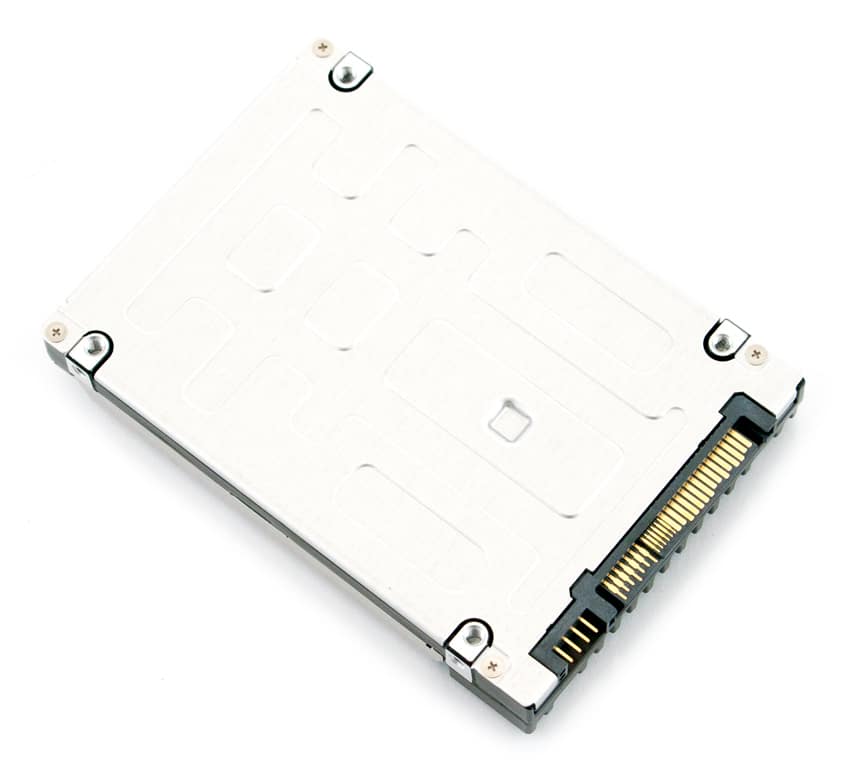
Flipping the drive over shows the bottom metal plate with dimples near locations with corresponding thermal pads touching the circuit board to dissipate heat.
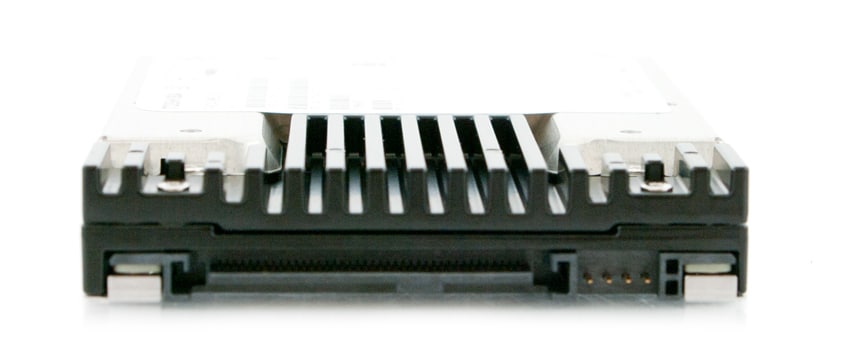
The interface of the drive is a dual port SAS connector supporting SAS3 12Gb/s transfer speeds.
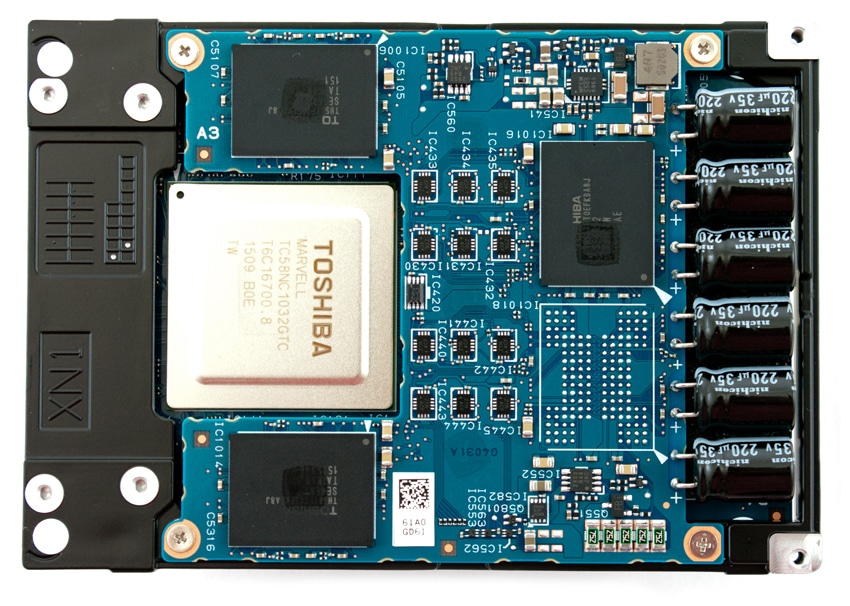
Looking under the hood, we see a Marvell controller.
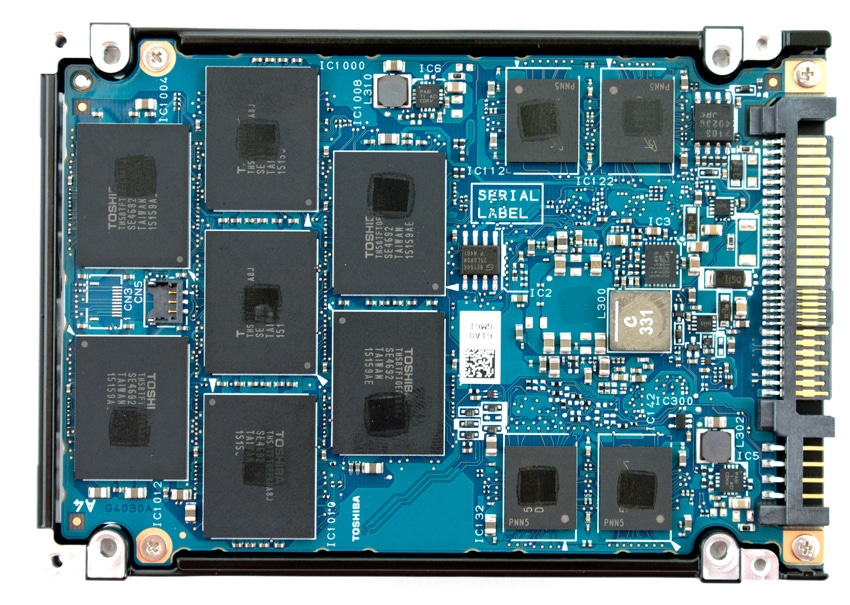
On the other side of the PCB we see the NAND packs giving the drive its capacity.
Testing Background and Comparables
The StorageReview Enterprise Test Lab provides a flexible architecture for conducting benchmarks of enterprise storage devices in an environment comparable to what administrators encounter in real deployments. The Enterprise Test Lab incorporates a variety of servers, networking, power conditioning, and other network infrastructure that allows our staff to establish real-world conditions to accurately gauge performance during our reviews.
We incorporate these details about the lab environment and protocols into reviews so that IT professionals and those responsible for storage acquisition can understand the conditions under which we have achieved the following results. None of our reviews are paid for or overseen by the manufacturer of equipment we are testing. Additional details about the StorageReview Enterprise Test Lab and an overview of its networking capabilities are available on those respective pages.
Comparables for this review:
- Toshiba PX03SN (800GB, Marvell co-branded TC58NC9036GTC controller, Toshiba's 19nm MLC NAND, 12.0Gb/s SAS)
- Hitachi SSD800MH (400GB, Intel co-branded DB29AA11B0 controller, Intel 25nm MLC NAND, 12.0Gb/s SAS)
- Toshiba PX02SM (400GB, Marvell co-branded TC58NC9036GTC controller, Toshiba 24nm eMLC NAND, 12Gb/s SAS)
- Toshiba PX02SM (800GB, Marvell co-branded TC58NC9036GTC controller, Toshiba 24nm eMLC NAND, 12Gb/s SAS)
- Toshiba PX02SS (400GB, Marvell co-branded TC58NC9036GTC controller, Toshiba 24nm eMLC NAND, 12Gb/s SAS)
- Seagate 1200 (400GB, Marvell controller, 21nm Samsung eMLC NAND, 12Gb/s SAS)
Application Workload Analysis
In order to understand the performance characteristics of enterprise storage devices, it is essential to model the infrastructure and the application workloads found in live production environments. Our first three benchmarks for the Toshiba PX04SMB are therefore the MarkLogic NoSQL Database Storage Benchmark, MySQL OLTP performance via SysBench and Microsoft SQL Server OLTP performance with a TCP-C workload.
Our MarkLogic NoSQL Database environment requires groups of four SSDs with a usable capacity of at least 200GB, since the NoSQL database requires roughly 650GB of space for its four database nodes. Our protocol uses an SCST host and presents each SSD in JBOD, with one allocated per database node. The test repeats itself over 24 intervals, requiring 30-36 hours total. MarkLogic records total average latency as well as interval latency for each SSD.
Using our MarkLogic NoSQL database benchmark, the PX04SMB posted the lowest latency at 1.312ms.
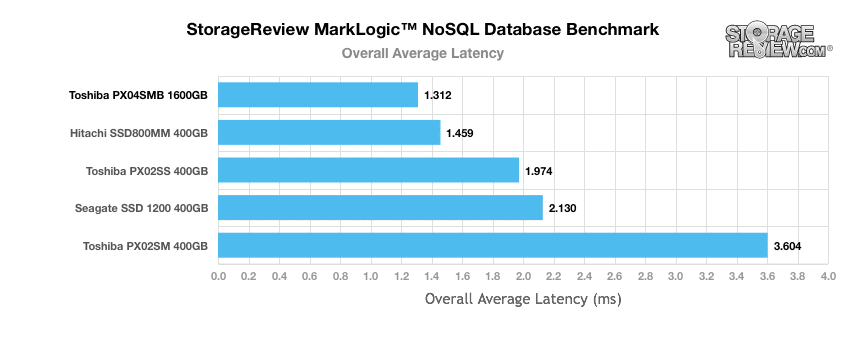
Looking at the detailed overall latency performance of the PX04SMB in our NoSQL benchmark, we see the drive maintained very low latency over the duration of the test. The drive had a handful of spikes throughout, but was more consistent than the comparable drives.
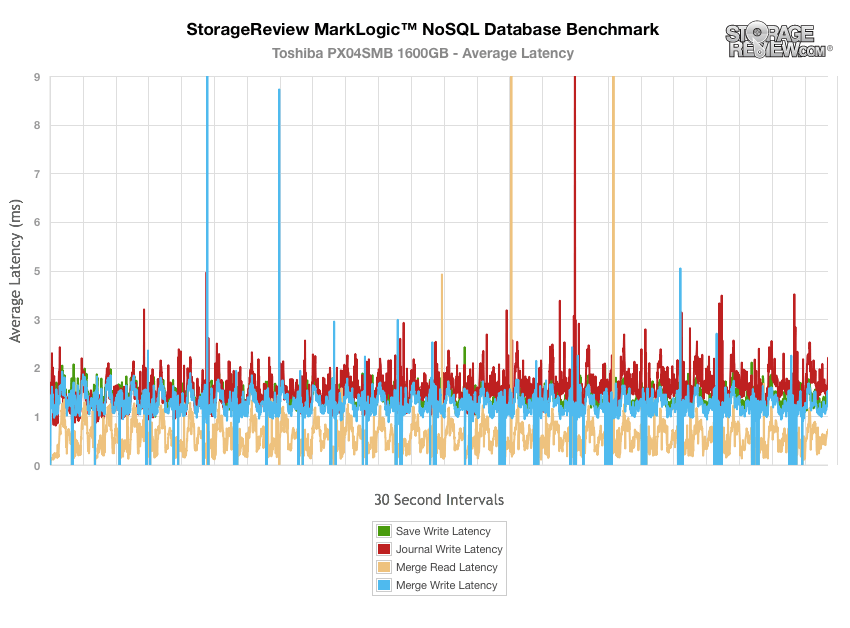
StorageReview’s Microsoft SQL Server OLTP testing protocol employs the current draft of the Transaction Processing Performance Council’s Benchmark C (TPC-C), an online transaction processing benchmark that simulates the activities found in complex application environments. The TPC-C benchmark comes closer than synthetic performance benchmarks to gauging the performance strengths and bottlenecks of storage infrastructure in database environments. Our SQL Server protocol uses a 685GB (3,000 scale) SQL Server database and measures the transactional performance and latency under a load of 30,000 virtual users.
The PX04SMB placed at the top again with 6,319.7 TPS beating the Hitachi by a little over 40 TPS.
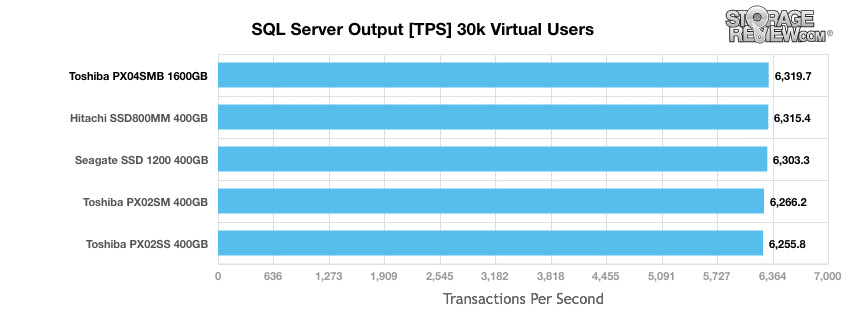
Looking at average latency there really is no comparison. The PX04SMB beat the other comparables hands down with a latency of 3ms less than half the latency of the next closest comparable.
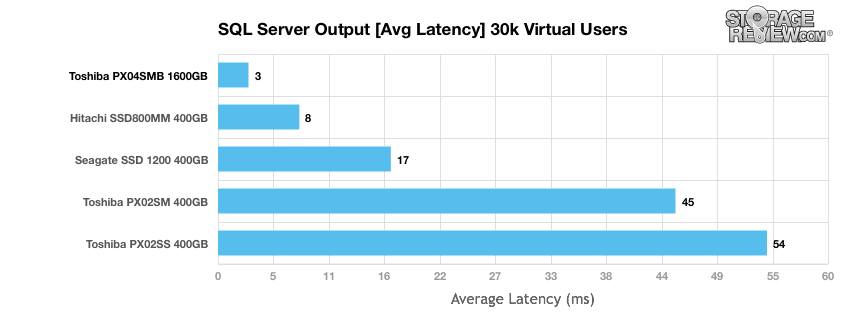
Our next application test consists of Percona MySQL database test via SysBench, which measures the performance of OLTP activity. In this testing configuration, we use a group of Lenovo ThinkServer RD630s and load a database environment onto a single SATA, SAS or PCIe drive. This test measures average TPS (Transactions Per Second), average latency, as well as average 99th percentile latency over a range of 2 to 32 threads. Percona and MariaDB are using the Fusion-io flash-aware application APIs in the most recent releases of their databases, although for the purposes of this comparison we test each device in their "legacy" block-storage modes.
In average transactions per second, the Toshiba PX04SMB started off strong and maintained its lead throughput peaking at 2,405.2 TPS. It was the top performer every step of the way from beginning to end.
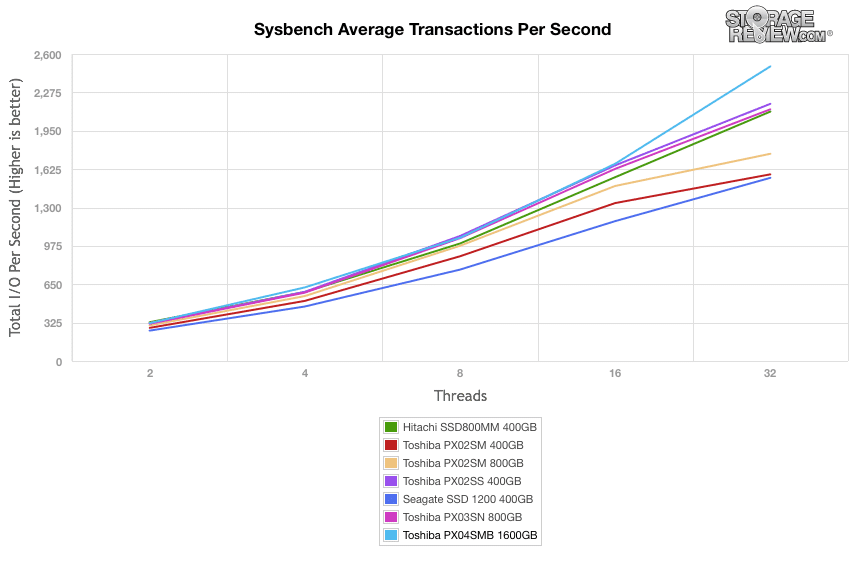
Looking at average latency in in our MySQL protocol, we again see the PX04SMB come off as the top performer, however it didn’t have quite as large of a lead.
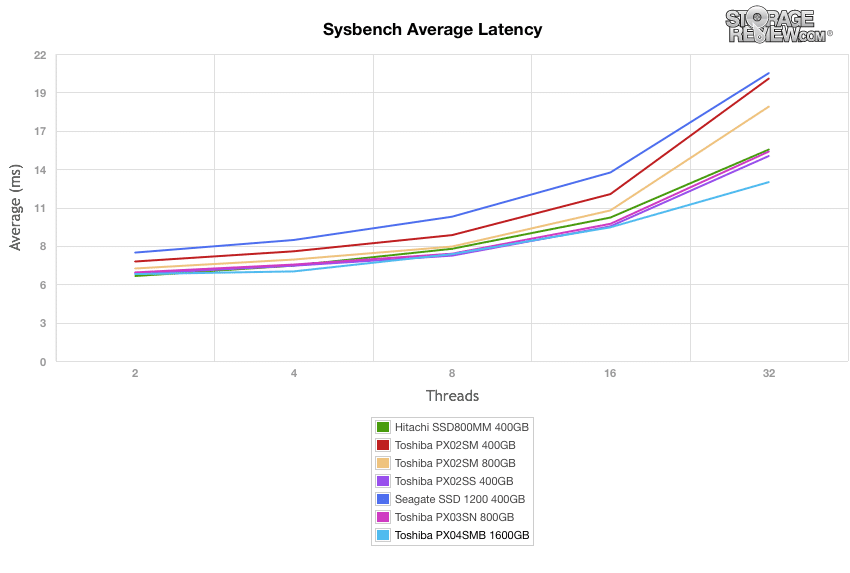
The Sysbench Average 99th Percentile plot highlights worst-case latency performance for our comparables. Once again we see a strong performance by the PX04SMB putting it in the top spot. The next closest drive being the Hitachi.
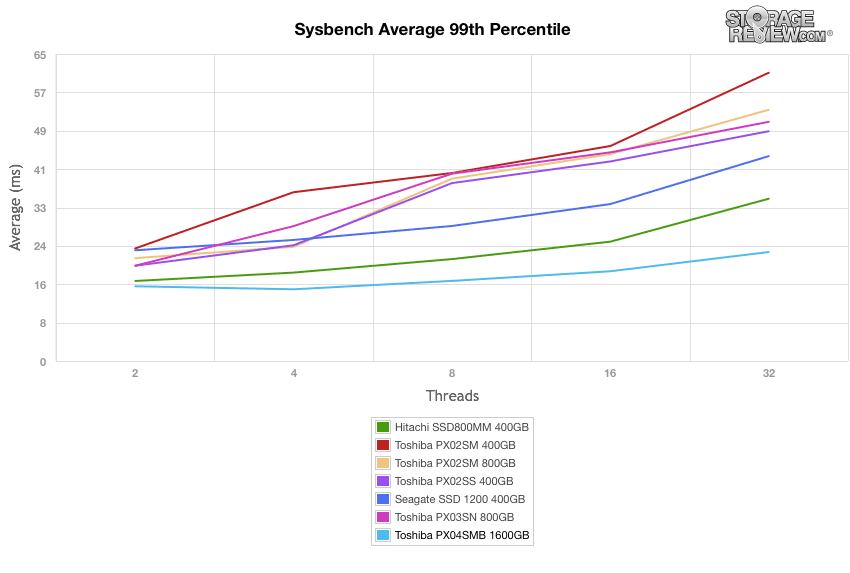
Enterprise Synthetic Workload Analysis
Flash performance varies as the drive becomes conditioned to its workload, meaning that flash storage must be preconditioned before each of the fio synthetic benchmarks in order to ensure that the benchmarks are accurate. Each of the comparable drives are secure erased using the vendor's tools and preconditioned into steady-state with a heavy load of 16 threads and an outstanding queue of 16 per thread.
- Preconditioning and Primary Steady-State Tests:
- Throughput (Read+Write IOPS Aggregate)
- Average Latency (Read+Write Latency Averaged Together)
- Max Latency (Peak Read or Write Latency)
- Latency Standard Deviation (Read+Write Standard Deviation Averaged Together)
Once preconditioning is complete, each device is then tested in intervals across multiple thread/queue depth profiles to show performance under light and heavy usage. Our synthetic workload analysis for the Toshiba PX04SMB uses two profiles which are widely used in manufacturer specifications and benchmarks.
- 4k
- 100% Read and 100% Write
- 8k
- 70% Read/30% Write
In our throughput 4k write preconditioning test, the PX04SMB started off with a throughput over 50% higher than its next competitor. The PX04SMB started off running in the 170K-180K IOPS range while the next closest, the Hitachi, was running in the 110K range. After being brought into a steady-state the PX04SMB was running around 90,000 IOPS, the Hitachi drive was second running around 66,000 IOPS.
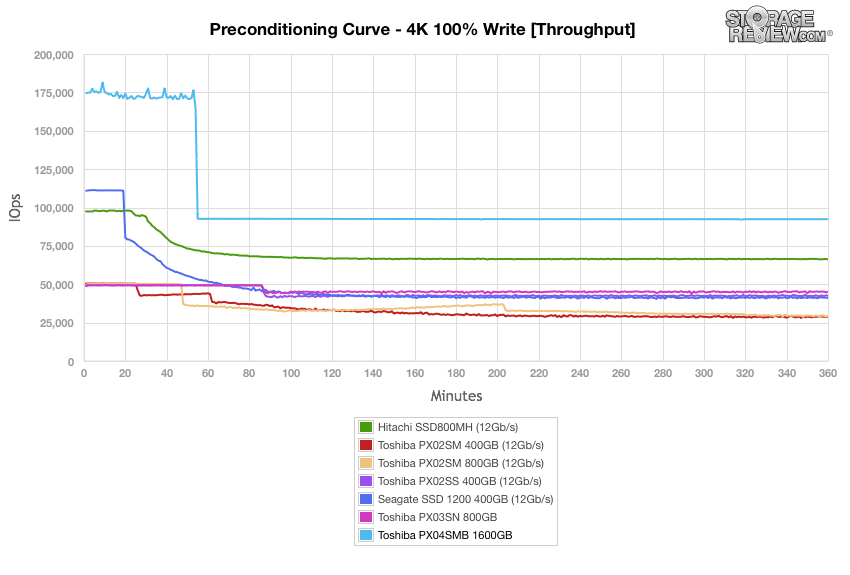
The PX04SMB also reigned in the average latency start off at a mere 1.47ms and settling into a steady state of about 2.77ms. The PX04SMB’s steady state was lower than most of the other drives starting latency.
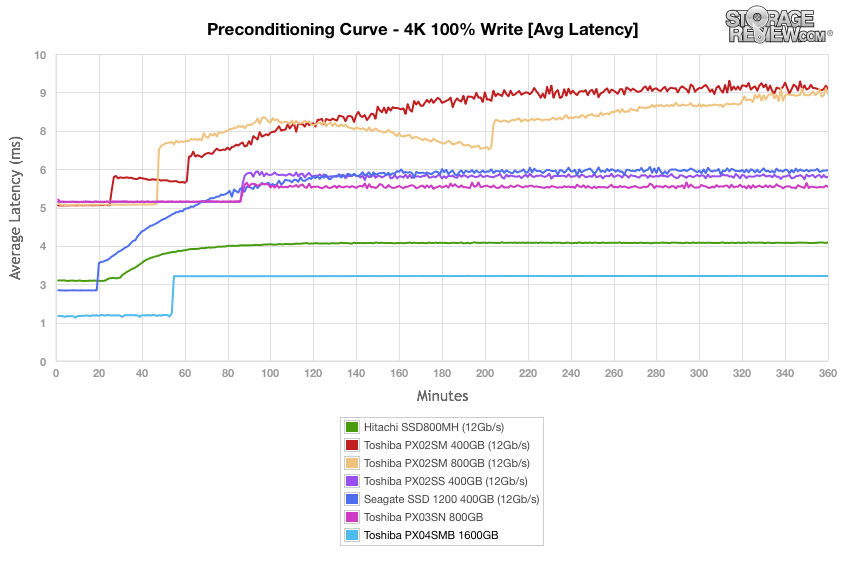
The max latency showed similar placement for the PX04SMB. It started off around 11ms and finished around 12ms. While it had the best latency from overall it did have a huge spike at about the 3 hour mark jumping all the way to 183.66ms.
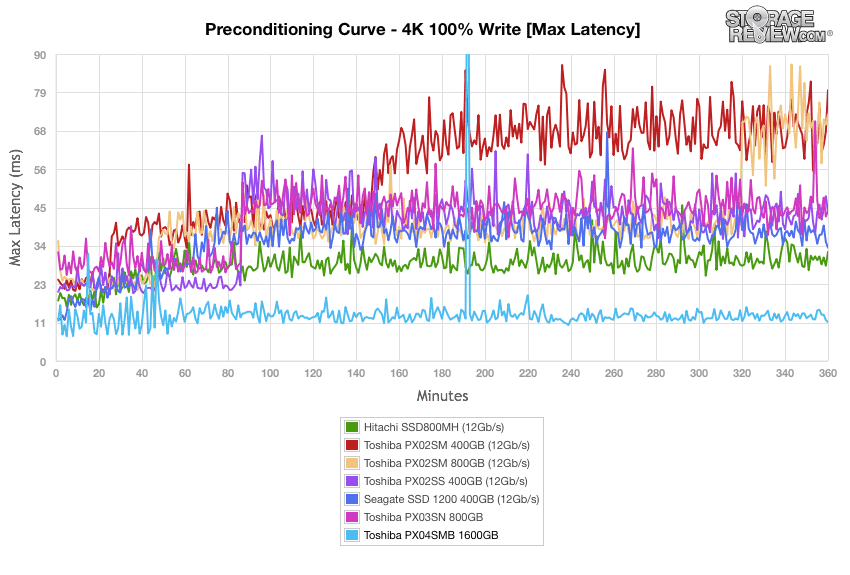
Standard deviation calculations make it easier visualize the consistency of the PX04SMB's latency performance results. Once again the drive was the best of the pack without question. There was also a spike around the 3 hour mark but this time much lower, 1.82ms.
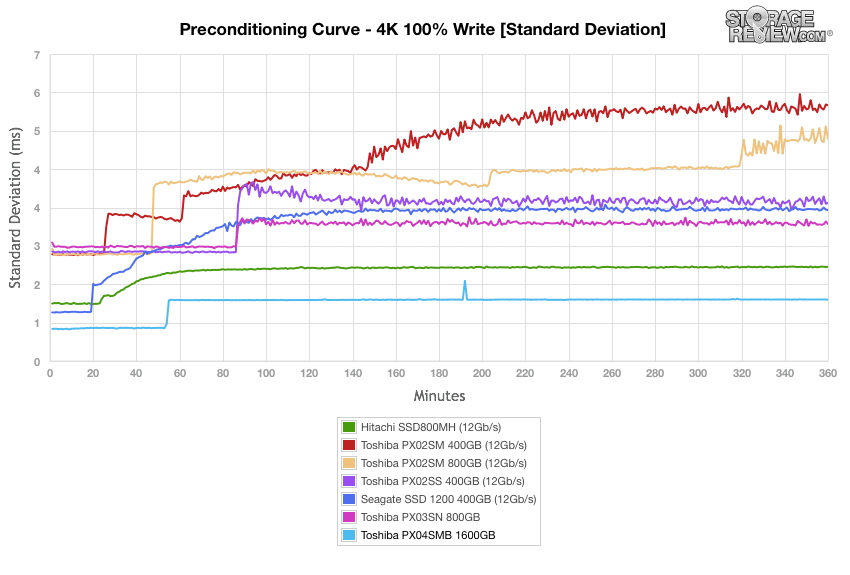
During the primary 4k synthetic benchmark, the Toshiba PX04SMB crushes its competitors in throughput performance. For read performance the PX04SMB gave us 177,378 IOPS and for write we saw 92,335 IOPS. The second place, the Hitachi, trailed by about 30,000 IOPS in both read and write performance.
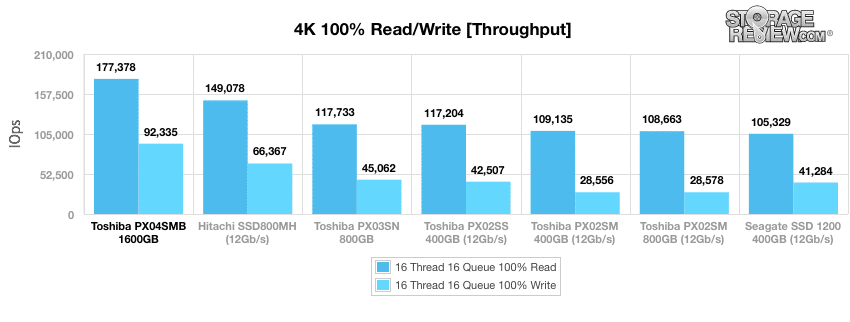
Average latency results for the 4k workloads continue to place the PX04SMB on top but not by quite so large a margin. The drive’s average latencies were 1.44ms for read and 2.77ms for write.
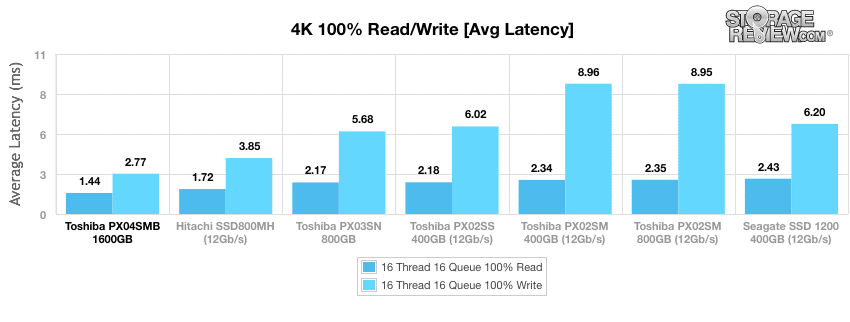
Max latency shows the first stumble of the PX04SMB. Wile it has had little trouble blowing past its competitors up to this point it does score the worst read latency test at 53.26ms. On the flip side, it has the best write latency at 17.19ms, over twice as fast as the nest drive.
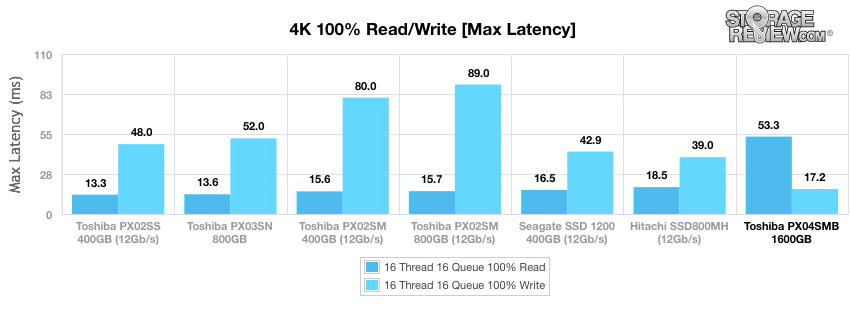
Going to standard deviation, the PX04SMB shrugs off the results of the last test to once again take the top spot in both read and write with speeds of 0.58ms and 1.42ms respectively.
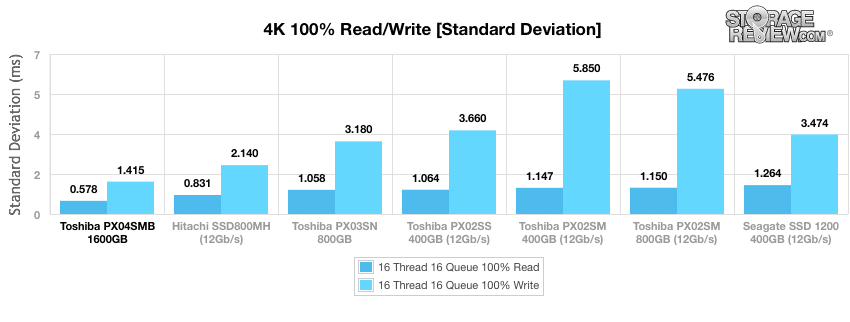
Our next workload uses 8k transfers with a ratio of 70% read operations and 30% write operations. While not quite as strong a lead as it enjoyed in the 4K preconditioning, the PX04SMB was without a doubt the top performer. It’s initial burst speed of around 120K IOPS, steady state performance finished around 105K IOPS with the next closest performer finishing around 64K IOPS.
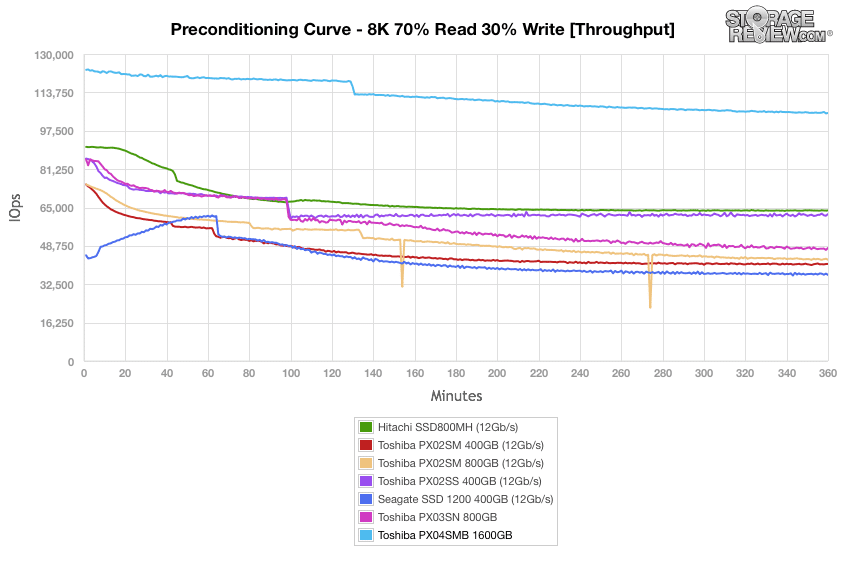
With average latency the PX04SMB was first hands down. Not only did it have the lowest latency, it had the most consistent starting at around 2ms and finishing around 2.4ms.
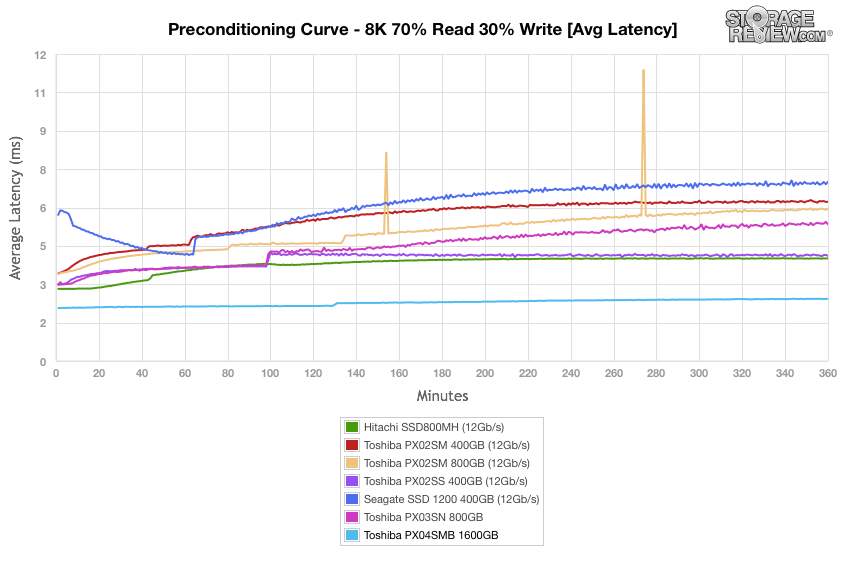
Max latency shows a very similar picture to the one above with the PX04SMB having both the lowest and the most consistent latency ranging between 10-16ms.
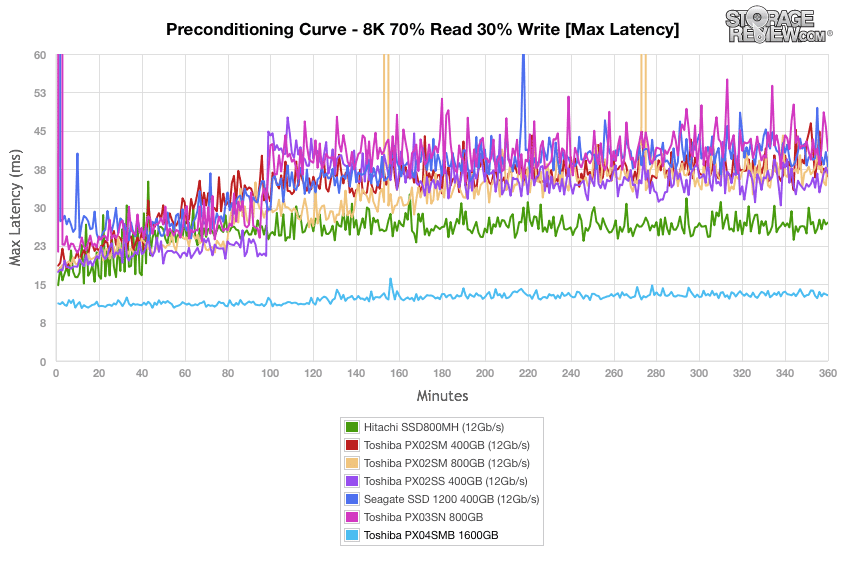
Standard deviation calculations for the 8k 70/30 preconditioning place that maximum latency anomaly in the context of an otherwise consistent and unremarkable latency profile during the approach to steady state.
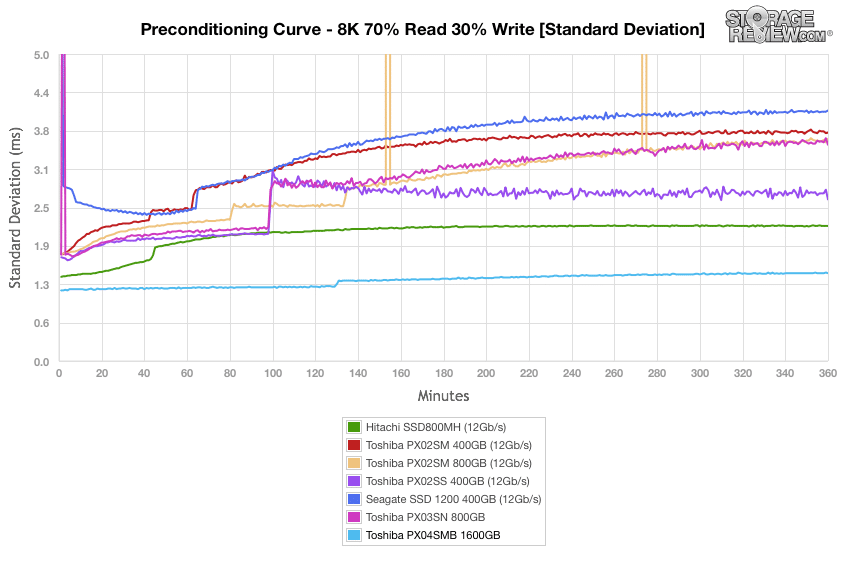
Once the drives are preconditioned, the 8k 70/30 throughput benchmark varies workload intensity from 2 threads and 2 queue up to 16 threads and queue of 16. The Toshiba PX04SMB easily took the top spot with a peak performance at 105,105 IOPS.
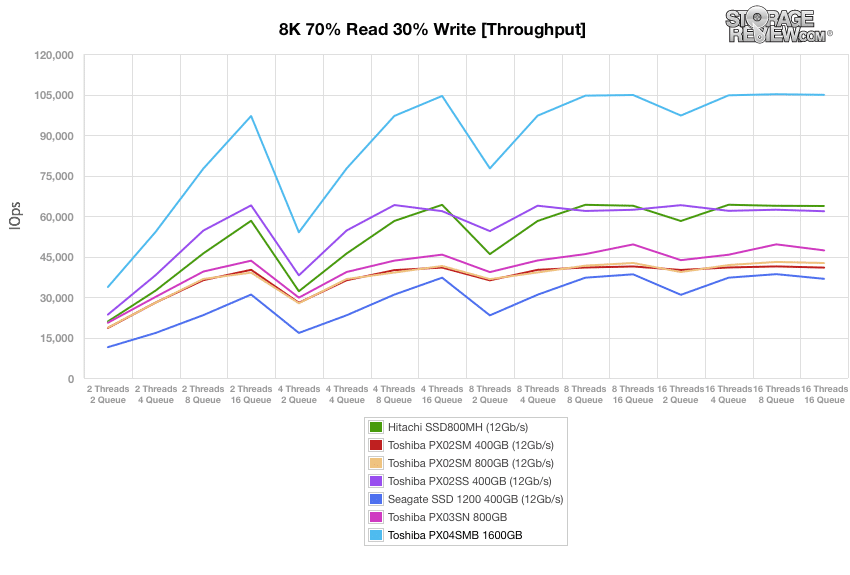
With average latency the PX04SMB started off and stayed strong throughout achieving better comparative latency as the test finished.
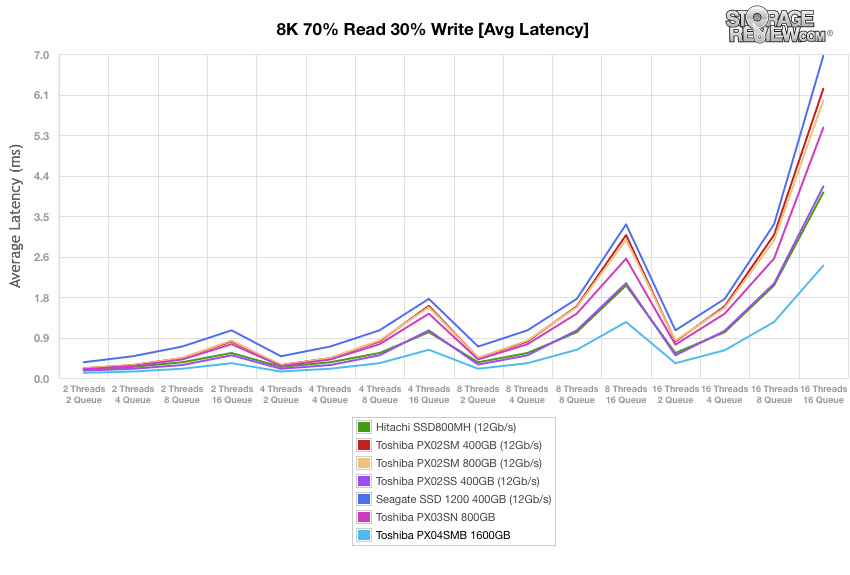
With max latency the PX04SMB once again had the lowest and most consistent latency.
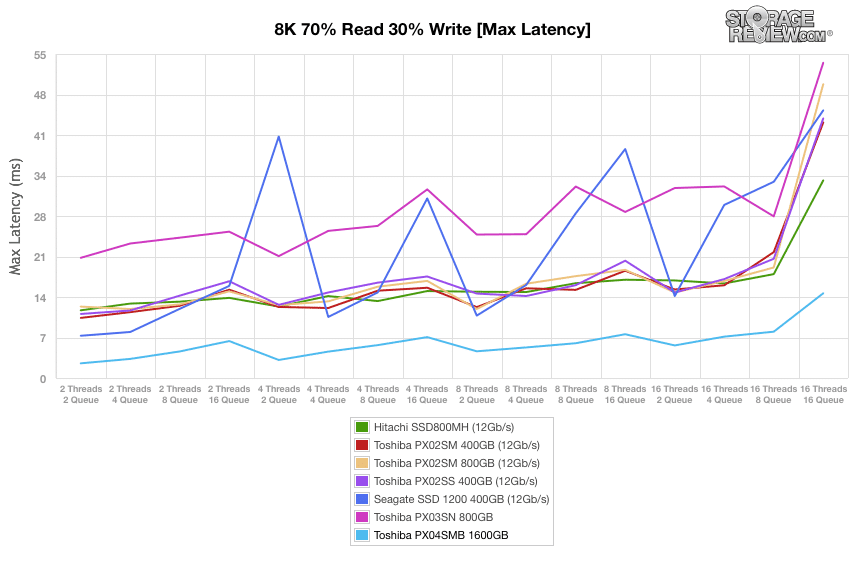
Measured in terms of standard deviation, The PX04SMB was again the top performer with the Hitachi trailing right behind.
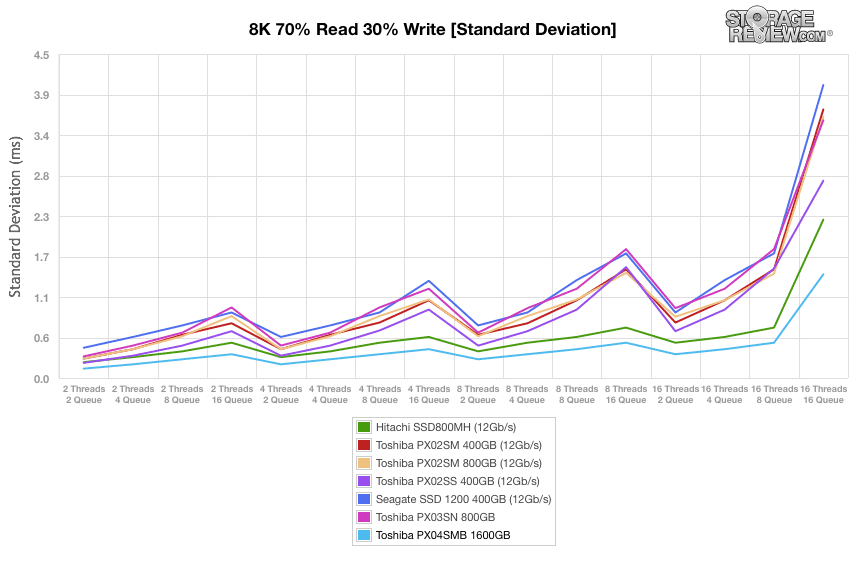
Conclusion
The PX04S series are Toshiba's new third generation SAS SSDs designed for a variety of enterprise workloads. The new line is designed and built all in-house by Toshiba as a total vertically integrated solution. The drives come in four different models aim at particular endurance and read/write needs, the highest having up to 25 complete drive writes per day. Toshiba states that it is the highest capacity 12Gb/s SAS SSD with the max capacity just under 4TB. The drives also come with a performance option that allows for an increase in writes, though this requires extra power consumption. Toshiba offers a self-encrypting model with secure erase and the drives come with Toshiba’s 5-year warranty.
Looking at performance the PX04SMB drives we tested didn’t just perform better than the other drives tested against it, it blew them out of the water. It has given us some of the best performance overall for any SSD in this class. The PX04SMB came out on top in our application workload analysis, dominating the field across the board. New highs were set for the SAS category in all three tests.
The drive continued to shine in the enterprise synthetic tests. In the 4K preconditioning the PX04SMB outperformed the closest competitor by about 50%. In the 4K preconditioning the PX04SMB had a better steady-state performance than the some of the burst performances of the other dives. In other 4K synthetic benchmark the PX04SMB had throughput number 30,000 IOPS over the second place drive, with 177,378 IOPS read and 92,335 IOPS write. The great performance continued on through our 8K 70/30 tests as well. In fact, aside from a few spikes in latency, the only time the PX04SMB didn’t come out on top was our 4K max latency, where its read speeds the worst however its write speeds for still the best.
In total the Toshiba PX04SMB is exceedingly impressive. The numbers show that Toshiba continues to find huge benefits with their vertically integrated strategy. The wide offering of drives in this family also provides a solution for about every workload, including multi-tier all flash arrays. Lastly, with a top-end capacity of nearly 4TB, Toshiba has a complete suite of offerings designed to meet a vast majority of the enterprise demand for SAS flash as it sits today.
Pros
- The overall best performance we have seen from any enterprise SSD in our lab to date
- Highest capacity dual port SAS SSD as of this writing
- 4 models offered for specific use cases
Cons
- On our 4K tests the PX04SMB had the highest max read latency (but best standard deviation)
The Bottom Line
The Toshiba PX04S are 2.5” enterprise SAS SSDs that provide massive performance and enough different models to suit most use cases. The mid-endurance model we tested showed chart-topping performance throughout, setting a new watermark for SAS SSDs.




 Amazon
Amazon